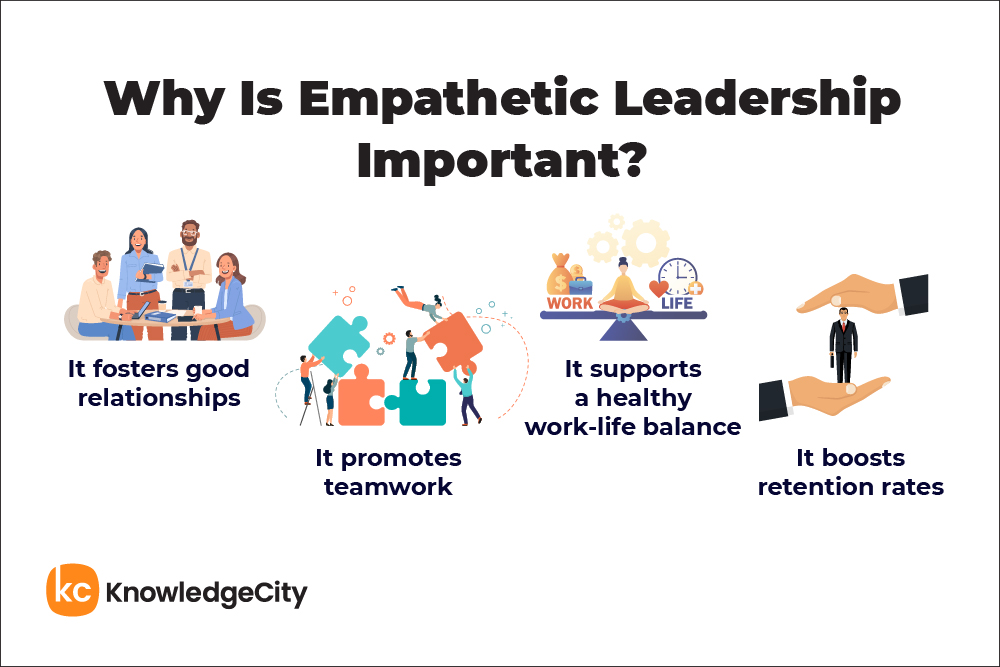Empathetic leadership is becoming a more common practice among leaders in today’s workplaces. Being an empathetic leader means displaying a genuine interest in the rest of the team. Empathetic leaders tend to have a high level of emotional intelligence that helps them understand how their team members are feeling, especially during challenging times.
Empathetic leadership became more prominent following the COVID-19 pandemic in 2020, when employees experienced changes and challenges related to work, child care, health care, and social welfare. Leading with empathy allows leaders to respond with compassion and authenticity while also boosting productivity.

What’s an Empathetic Leader?
Empathetic leaders show empathy in the workplace. They don’t just acknowledge or recognize others’ feelings; they feel compassionate toward—and empathize with—those feelings. If an employee is sick, the leader accepts their absence and offers words of sympathy. They insist that the employee rest and recover before coming back to work.
Empathetic leaders are also flexible and understand that life exists outside of work. This type of leader understands that child care challenges exist, commutes can be unpredictable, and employees’ health should outweigh the work being done. Practicing empathy means that a leader can adapt to almost any circumstance while still being effective and productive.
Of all the types of leadership, empathetic leaders tend to display the most compassion. Having sympathy and concern for employees can reduce turnover and increase productivity. For example, if an employee has always been a great employee—they’re on time, efficient, and they produce good work—comes in late one day, a compassionate thing to say would be, “Is everything OK?”
That leads to better morale than saying something like, “Why are you late?” That could make the employee feel attacked.
Empathetic leaders start with their own emotions. As mentioned before, they tend to have high emotional intelligence, which is the ability to manage one’s own emotions while understanding others’ emotions. Having this trait helps leaders to keep their biases, perceptions, and reactions in check during any situation.
Empathetic leaders are also seen as more approachable. Because they’re easy to deal with, employees feel comfortable talking to them, expressing challenges that may exist, and suggesting ideas.
While many types of leadership share characteristics, there are several that are common to empathetic leaders. They recognize, predict, and understand how to meet the emotional needs of team members. They utilize their emotional intelligence daily in difficult situations and actively listen to gain perspective.
Empathetic leaders also promote employee unity and cultural diversity. Since empathy starts from the top, those leaders who actively display their empathy tend to foster a work culture where empathy is present among the entire team.
Leaders who practice empathy in the workplace also express and understand what team members are going through; and they have a genuine interest in what team members feel and say.
Why is Empathy Important to Leadership?
There are many advantages to practicing empathy in the workplace. Some of the benefits of empathetic leadership include:
It builds good relationships. Relating to others can strengthen relationships, increase trust, and improve communication. Using empathy shows employees that their perspectives and experiences matter.
It promotes teamwork. Effective leaders create a culture based around their leadership style. Similarly, empathetic leaders create an empathetic culture which can lead to better team communication and inclusion. In fact, 50% of employees with highly empathetic leaders experience inclusion compared to 17% of employees with less-empathetic leaders.
It supports work-life balance. Empathetic leaders recognize and sympathize with the fact that life exists outside of the workplace. When employees feel that leaders are empathetic, they’re better able to balance work with personal obligations.
It boosts retention rates. Leaders who use empathy invest in creating a supportive and inclusive culture. In turn, the employees of empathetic leaders feel supported and included, and are more likely to invest themselves into the organization.
It maximizes productivity. Empathetic leaders foster a workplace where employees are less likely to feel exhausted because of work, making them more productive.
It encourages innovation. Employees with highly empathetic leaders are more creative and engaged than those with less empathetic leaders. When employees feel related to and understood, they tend to feel more comfortable with expressing new ideas.
Strategies for Leading With Empathy
Implementing leadership strategies with empathy utilizes many soft skills that leaders can display routinely. The key for leaders is to be deliberate and reflective in how those skills are used.
Be authentic. Displaying fake empathy will produce fake results. It’s not enough to pretend to understand others’ feelings; a leader needs to truly empathize with others to be effective.
Be vulnerable. Empathetic leaders tend to be in touch with their own feelings while also being compassionate toward others’ feelings.
In many cases, this can require the leader to confront their own feelings in order to better relate to an employee’s feelings; but doing so also allows the leader to set an example for others. The active giving and receiving of empathy between leaders and employees helps create a culture of empathy throughout the workplace.
Active listening is a significant component of empathetic leadership. It includes focusing attention to observe, process, and understand nonverbal communication. It also includes asking questions for clarification and to get a better understanding of how others are feeling.
Finally, acknowledge success. Just as empathetic leaders share the feelings of others in difficult or challenging situations, they should also share those feelings in times of celebration—both personal and professional.
An employee secured a new client? Acknowledge the success! An employee is having a baby? Celebrate it! The more leaders can relate and share compassion with their employees, the more positive the results of empathetic leadership are.
Empathetic leadership helps build strong relationships with employees, allows leaders to understand the needs and motivations of employees, and contributes to a positive overall work environment.
Subscribe to Our Newsletter
Join 80,000+ Fellow HR Professionals. Get expert recruiting and training tips straight
to your inbox, and become a better HR manager.

 Erin Shankie
Erin Shankie 

